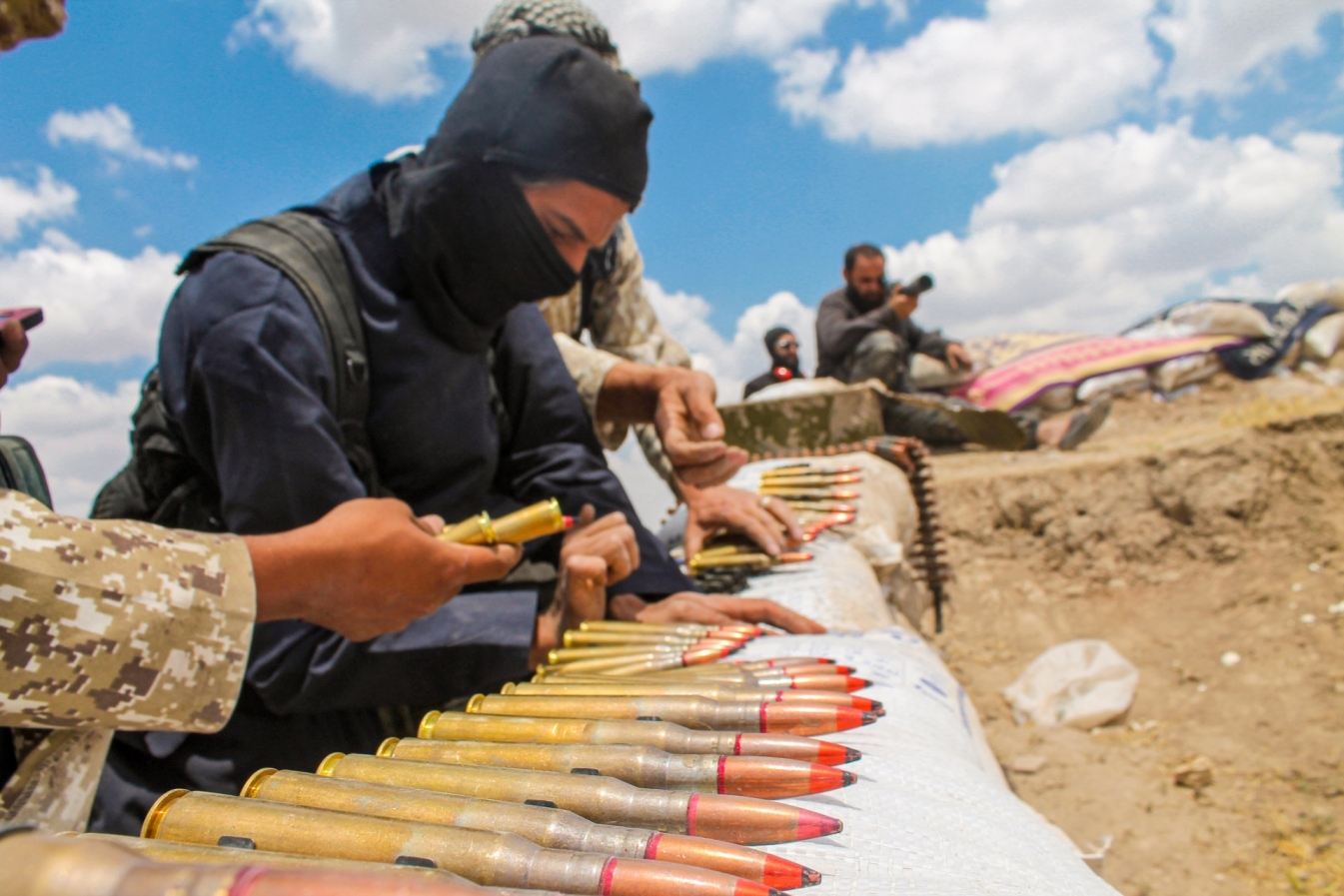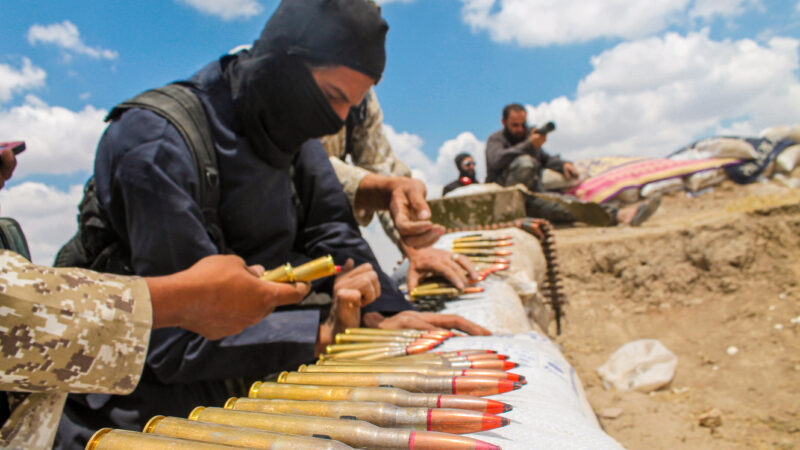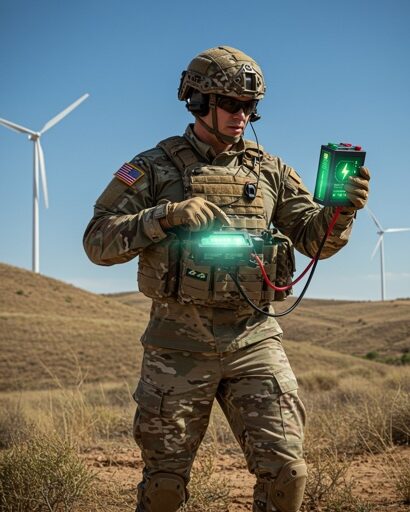Abstract: The battle of Hasakah in January 2022 showed that the Islamic State is still capable of conducting successful large scale operations involving several dozen of fighters. It shows how resilient modern terrorist organizations can be. The goals of the new terrorists are global, and they aim at a complete transformation.
Bottom-line-up-front: The democratic constitutional state must prepare itself for the future challenges of supra-regional, global terrorism. This also includes dealing with the phenomenon of encountering an increasingly militarily active non-state opponent. Combating such challenges, in turn, may lead to the necessity for deploying military forces at home. National legislation must be critically examined, and efforts must be made to adapt it to new circumstances.
Problem Statement: Does the continuing persistence of IS and similar organisations across the MENA pose unusual challenges for the democratic state, and what tools can we use to undermine/defeat such groups?
So What?: The threat of terrorist organizations remains challenging, and developing effective counter-terror strategies will remain one of the great challenges of the 21st century. However, in confronting this challenge, the democratic understanding of the law and its fundamental pillars and goals, such as human dignity, freedom, justice, and legal security, must not be undermined.

Source: shutterstock.com/Mohammad Bash
Hasakah
On January 20, 2022, the Islamic State (IS) attacked the al-Sina’a prison in the Syrian city of Hasakah. The aim was to free IS-fighters held in the prison. After nearly one week of fighting, the result was grave. It is reported that 400 IS fighters escaped, and 374 were killed. In addition, a further 117 Kurdish security forces were killed. This attack — the largest undertaken by the IS since it lost its last key Iraqi and Syrian territories in 2019 — was a major propaganda victory for the IS.[1]
Until the 1980s, many terror attacks were conducted by small, regional-revolutionary and national movements, often acting asymmetrically. However, many of these were internationalized, with the result that the relevant security forces could often manage terror attacks. This changed when the motivation of terrorist groups shifted towards religious fanaticism. In 1968, Bruce Hoffman, working for the RAND Corporation, noted that, of thirteen identifiable terrorist movements, not a single one could be classified as religious.[2] In 1995, 26 of 56 movements were considered religiously motivated. Possibly the first religiously motivated assault to attract global attention occurred in February 1993, when a previously unknown organization called Al-Qaida bombed the World Trade Center in New York.[3]
Today, terrorist organizations are increasingly gaining support, especially among the populations of the Muslim World. Despite the efforts of Western nations, support is not diminishing; on the contrary, it is slowly but steadily increasing, and increasing support for terrorist and Islamist ideas seems obvious.[4]
The foundation of Islamist terrorist movements was often Salafist ideas. The ostensible goal was to return to the “true” teachings of the Koran, which these groups accepted as the only ones, and to wage war against all those who stood outside this form of Islam. In the process, the term “jihad” is repeatedly bandied about. While this word is often interpreted as the primary effort of every Muslim in his or her life, it is also seen as a call to fight against those things perceived to be un-Islamic. The goal of Islamic terrorism is to establish a “true” Islamic state and social order. Violence is seen as the only way to bring the jihad to a successful end.[5] The Islamists’ fight is against “crusaders”, “Jews” and “infidels”, as well as their “henchmen”. Jihad is waged globally and includes physical and psychological attacks wherever necessary. The strategy distinguishes between the fight against “near” and “far” targets.
While this word is often interpreted as the primary effort of every Muslim in his or her life, it is also seen as a call to fight against those things perceived to be un-Islamic. The goal of Islamic terrorism is to establish a “true” Islamic state and social order.
For example, the governments of the Muslim states are to be overthrown first, and only then the West is to be subjugated. The leaders of AQ and subsequently the IS made sure that these messages were heard worldwide. Spectacular terrorist attacks underpinned them. Islamic terror attacks and the resulting fear and the uncertainty they caused glamorized jihadism leading to the inspiration of new fighters. Such religiously motivated fighters joined battle with the “infidels” in the Balkans from the mid-1990s, subsequently in the Caucasus, in Afghanistan from 2001, and Iraq from 2003.[6]
The widespread and continuous nature of such terroristic engagement bequeathed a breadth of operational experience which was subsequently exported to destabilize other regions. The Sahel is a primary example of this phenomenon, with germ cells of Islamist terrorism emerging here. The formation of cells was not limited to war zones but also occurred in the West. Since the death of Osama bin Laden, AQ has increasingly taken a back seat, while IS and its leader Abu Bakr al Baghdadi took its place as the primary focus of jihadist violence.[7] More and more Islamist terrorist groups have pledged the Bai’a —the Islamic oath of allegiance— to the IS. In many Muslim countries, offshoots of the IS have formed, and the group’s popularity has grown among the populations.[8] As in previous decades, Islamist terror has not stopped at the gates of Europe. Here, it continues to pose enormous challenges for the police and military security forces.[9]
Terrorism as part of an Asymmetric or Irregular Warfare Strategy
Different countries (e.g. USA, UK, Germany) and International Organizations offer different explanatory models for asymmetric or irregular warfare. A variety of terms exist on the subject, such as Small War, Unconventional Warfare, Three Block War, 4th Generation War, Irregular Warfare, Subversive War, Insurgency, Guerilla War, Military Operations other than War, Low-Intensity Conflict, Asymmetric War and last but not least Revolution, Partisan War and Terrorism.[10] As a crucial actor in the fight against terrorism, western military thinkers distinguish between five types of asymmetric or irregular warfare: Coup d´état, Terrorism, Revolution, Insurgency, Civil War.[11] In addition, within each of these forms, the exercise of terror can represent a means (or strategy) of warfare. With this classification in mind, the following can be said about the definition and concept: Terrorism is a form or strategy of asymmetric or irregular warfare in the modern military understanding. Herfried Münkler aptly summarizes this:[12]
“Terrorism is the practice of using violence by actors who are clearly inferior to their opponents in terms of resources and who want to achieve political goals through the psychological effects of physical violence. The term “ism” stands for the fact that these are not individual actions, but rather campaigns that are planned for a longer period of time, reflexively and strategically.”
Among the most militarily successful terrorist organizations of the 21st century are AQ and the IS. While AQ operated mainly behind the scenes, IS brought large areas under its de facto control. For a few years (mainly between 2014 to 2016), it seemed as if the advance of IS could not be stopped. However, today, it seems as if the IS’ days are numbered. This situation is mainly the result of a coordinated multinational effort by military intelligence services and the targeted deployment of special and security forces.[13]
While AQ operated mainly behind the scenes, IS brought large areas under its de facto control. For a few years (mainly between 2014 to 2016), it seemed as if the advance of IS could not be stopped.
In IS’ heartlands in Syria and Iraq, defeat has followed defeat in recent years, and its supporters seem to be fighting an increasingly hopeless battle. In fact, despite the successes of the intelligence services and security forces, IS still manages spectacular successes. Its offshoots in the Sahel (ISGS) and Afghanistan (ISIS-K) remain militarily active. Ongoing analyses by international military intelligence services indicate that an increased movement of fighters into the European area is still to be expected.[14] The attacks that have taken place on European soil in recent years may only have been a foretaste. As the battle in Hasakah has shown, the IS can still conduct large complex operations. Therefore, it seems appropriate to analyse the techniques and tactics these fighters might take to Europe.
The Secret of Extraordinary Success
The territorial conquest successes in Syria, with the almost “peaceful” capture of the Sunni areas of western Iraq and the fall of the million-strong city of Mosul, signified an enormous success for the IS. In December 2015, the IS came close to capturing Aleppo, a city of millions. In Iraq, its devastating attacks in Baghdad led to chaos and insecurity. While the international community disagreed on what to do, the US began sending troops back into Iraq. The task faced by the US now was to prevent an imminent collapse of the Shiite Iraqi government.
Meanwhile, thousands of young men from all over the world flocked to Syria and Iraq to make sense of their lives: Fighting for Allah against the infidels or heretics who have fallen away from the faith (such as Alawites or Shiites). The IS used the next few months to exploit its victories for propaganda purposes, secure conquered territories, and capture new ones. On January 07, 2015, IS sympathizers stormed the newspaper editorial office of Charlie Hebdo, and to this day, Europe, in particular, is experiencing an increase of terrorist attacks. The IS had achieved decisive successes in only a short time. It had managed to make many members of the Muslim World identify with its goals and successes. The “accolade” for any terrorist organization. The ideas and ideals of the IS had become self-perpetuating.[15]
But how could a few become so many? How could it be that a dozen terrorists, some of them young, with Ak-47’s, with a few pick-ups and a black banner bearing the Islamic creed and the seal of the Prophet (and thus representing familiar symbols of identification for the entire Islamic world), could achieve one success after another? Iraqi troops equipped with American M1 Abrams tanks and Syrian regime forces with Russian-made tanks and armored personnel carriers fled headlong at the sight of black flags and abandoned their positions by the hundreds. Even Turkish forces had to endure the loss of an entire company of Leopard 2 A4 tanks in the battle for the Syrian city of Al-Bab at the end of 2016. Not to speak of rival (Sunni and Kurdish) rebel groups who were virtually eliminated by IS fighters as they marched past. However, all these successes reveal exact military patterns of action that, upon closer inspection, could be taken from a military manual.[16]
How could it be that a dozen terrorists, some of them young, with Ak-47’s, with a few pick-ups and a black banner bearing the Islamic creed and the seal of the Prophet, could achieve one success after another?
According to the NATO and EU Capability Hierarchy, modern armed forces are defined by mapping a specific number of capability areas. Modern Armed Forces are constantly guided by development and capability goals. These are referred to as: Intelligence and Reconnaissance (Inform), Leadership (Consult, Command & Control), Operational Preparation (Prepare), Impact and Engagement (Engage), Force Protection (Protect), Force Projection (Project) and Support and Sustainment (Sustain). If a modern army possesses the characteristics of these capability areas, it is ultimately capable of multi-domain warfare or proactive cross-force command and control within the factors of force, space, time, and information. It seems that the IS has managed to map all these military capability areas of modern armed forces within a few years – in varying degrees of quality and sophistication, but in a complete and sustainable manner.
Inform – Accurate Situational Awareness as the Basis for Targeted Action
Unlike any other regional terrorist organization in the Near and Middle East, IS succeeded from the very beginning in establishing and operating a widely ramified network of informers and spies. Against the background of the intra-religious conflict between Sunnis and Shiites, the formerly dominant Sunni population developed a willingness to cooperate with the newly emerged Islamist terrorist organization. This made it possible to carry out assassinations on the leaders of the Shiite-dominated security forces. These assassinations were also documented and disseminated to the media. The well-known and infamous multi-part video series called “Dancing Swords” is one such example. The targeted killings intimidated the Iraqi security forces and drew the sympathy of the Sunni population. After all, the Shiite security forces were feared for their attacks on Sunni civilians. At the height of its success, i.e. the conquest of the city of Mosul with its millions of inhabitants, the IS knew through its system of informers exactly where to start, and the city was in its hands within a few hours. Therefore, many of the IS’ successes were possible because its leadership knew precisely where to deploy its armed forces, which were still few at the beginning.[17]
Consult, Command & Control – Tight Hierarchy Paired with Decentralized Order Execution
It is currently assumed that the IS leadership cadre is not necessarily recruited from ideologically stable and strictly religious men, as was initially assumed. On the contrary, time and again, indications suggest that a conglomeration of different characters has come together. Be it former Sunni intelligence and secret service officers on the one hand or young technology freaks immigrating from the west on the other. It can rightly be assumed that a manageable circle of thinkers have carried out a forward-looking strategy development at the core. In the beginning, the focus was on motivating the Sunni population to support them and only then on steadily developing their military capabilities. Looking at the IS’ fight in Syria in particular, it is striking that its targets were chosen wisely, especially at the beginning. The IS never tried to take over but often filled a vacuum that had arisen or cleverly played rival rebel groups off against each other. This was accompanied by a centrally controlled media campaign of a quality that was previously unknown. The professional presentation of well-known IS propaganda formats such as Dabiq, Amak or Rumajah are examples.
It can rightly be assumed that a manageable circle of thinkers have carried out a forward-looking strategy development at the core.
Certain rebel groups (such as Jabhat an-Nusra, which existed until 2017) were much more successful than IS in the beginning. However, they did not use the media to exploit their successes sufficiently. Soon, the first Syrian insurgents voluntarily joined the IS. The IS skillfully used a mix of local and imported fighters here. The self-proclamation of Abu Bakr al-Baghdadi as caliph and successor of the Prophet gave the IS overall strategy the necessary ideological and Islamist fine-tuning. Tight leadership, increasing military successes and ideological legitimacy gave the IS prestige and acceptance.[18]
Prepare – Forward Planning and Targeted Preparation
In the deployment of its forces, IS fighters differed fundamentally from other armed groups operating in the space. Through the targeted selection of capable and experienced leaders, the individual military operations were planned and considerably prepared. Precise plans were drawn up for necessary attacks based on a situational picture often generated over several weeks. The operational command was divided into phases, and precise roles were assigned to different available weapon systems. The reports of the Kurdish Peshmerga, who were repeatedly surprised by the attacks of the IS combat groups, provide some particularly impressive examples. To elaborate on the sophistication of IS operations, take the Zab River. This forms a natural border between the Iraqi provinces of Ninawa and Arbil. Despite a security line of Kurdish forces that existed before 2003, the IS repeatedly crossed the river, infiltrating fighters undetected and destroying entire Kurdish bases down to the last man. In addition, there were advances deep into the Kurdish hinterland where, among other places, attacks were carried out in the informal Kurdish capital Arbil. The situation was similar in Baghdad, where the IS repeatedly succeeded in carrying out devastating car bomb attacks despite the strong presence of the Iraqi security forces. In Baghdad, too, the IS was able to rely on the population of Sunni neighborhoods. Through careful planning, targeted analysis of weak points and preparation based on sympathizers, the IS succeeded in achieving successive spectacular successes.[19]
Engage – Initiative Maneuver Warfare and High Flexibility
It seems that the IS planners carefully studied the campaigns of the Umayyad dynasty in the 8th century. They also took inspiration from the campaigns of legendary historical equestrian peoples such as the Avars, Huns or Mongols. Their campaigns were characterized by the fact that they conquered large areas on horseback in a short time. Heavily armored armies of knights from the West were skillfully outmaneuvered or covered with arrows from a distance until they were worn down. The Umayyads had advanced along the North African coast, crossed the Mediterranean and invaded Spain. There they ruled until the 11th century. Like their Arab ancestors, the IS has been characterized by highly mobile operations from the beginning. Relying on light vehicles (e.g. primarily pick-ups) with medium armament, the open deserts of Iraq and Syria, in particular, offered the possibility of rapid advance. The first step was to capture every enemy position, which was easy to conquer in the vastness of the desert areas. The enemy bases were first encircled, then fired upon with large-caliber weapons, and stormed.
Relying on light vehicles with medium armament, the open deserts of Iraq and Syria, in particular, offered the possibility of rapid advance.
On the one hand, tactically insignificant checkpoints were attacked, and on the other, strategic nodes and cities were targeted. The flexible, highly mobile deployment of its forces allowed IS to exploit identified vulnerabilities and shift forces at will quickly. With the launch of the US Operation Inherent Resolve from autumn 2014 and the Russian intervention in Syria from September 2015, this approach of the IS was made considerably more difficult by the start of targeted airstrikes.[20]
Protect – Protection against Modern Weapon Systems
It would be easy to attribute IS’ success exclusively to its highly mobile operational command. This would also imply that its opponents always took flight during IS attacks. The opposite was often the case. The Iraqi and Kurdish garrisons desperately fought in their isolated and enclosed bases. They knew what would await them if the IS captured them. To this day, IS’ penetrating “precision weapons” are vehicles loaded with explosives, fitted with makeshift armor and driven by suicide bombers. So-called Suicide Vehicle Born Improvised Explosive Devices (SVBIED) have been used from the beginning and in all conceivable versions. They were used to breach or obliterate bases. If an attempted breach was insufficient, the following vehicle was brought in and detonated, and this would continue until the desired result was obtained. Short-range anti-tank missiles or heavy machine guns of the defenders were countered with appropriate armor. Alternatively, the IS used captured armored vehicles or tractors. The vehicles were loaded with several hundred kilograms of different explosives and blasting agents. Therefore, each detonation brought with it a devastating radius of destruction, far beyond the effective range of the defenders’ shoulder-launched anti-tank weapons. The only effective responses were long-range anti-tank guided weapons, deep armored trenches or barriers, or – as a last resort – flight from the attacker.
To date, IS has continued to refine the use of its SVBIED. Hundreds of SVBIEDs were used in the battle for Mosul. In the process, weak points in the Iraqi forces’ security lines were reconnoitred utilizing mini-drones and SVBIEDs. Armored trenches were countered at favorable points with makeshift armored construction machines. If a trench could be filled in, swarms of SVBIED followed. Finally, the drones used for reconnaissance were loaded with explosives and used, either by a deliberate crash or by dropping explosives. Sadly, with regards to SVBIEDs, there seems to be no shortage of drivers to this day. For such people, death for Allah represents the fulfilment of their greatest goal. The battle for Mosul offers a particularly stark example of the desire to die; here, IS took to hiding SVBIED’s in garages and activating them only after the Iraqi forces had passed. Thus, garage doors repeatedly opened in the back of the Iraqi forces and unloaded their deadly cargo. Alternatively, civilians were forced to ride along for “protection” against US airstrikes. Such operational tactics led to Iraqi special and security forces suffering up to 50% casualties in the battle for Mosul. With simple means, coupled with ideological brainwashing (and probably also coercion), the IS had succeeded in developing a highly successful simple weapons system.[21]
Project – Efficient and Highly Mobile Use of Low Forces
Despite successful local recruitment, the immigration of thousands of fighters from abroad and a high level of sympathy among the Sunni population, the IS was faced from the beginning with the challenge of holding and securing captured territories. Iraqi Mesopotamia, and Syria, is characterized by an urban concentration of inhabitants. Thus, the IS needed forces to hold these areas. However, these were not available to the IS in sufficient numbers. In many places, the solution was both simple and terrible. Through the use of brutal methods, such terror was exercised, often the mere mention of IS terrified people. We must acknowledge that fear by reputation is not new in warfare. Recall that the Hun, Mongol, and Ottoman advances into Europe spread fear and terror before them. These invaders often acted so brutally that the local population fled at the mere rumor of their approach. By consequence, hardly any prisoners were ever taken. This was a boon to the invaders as such would have needed to be guarded and fed. The Huns and Mongols had acted similarly before.
These invaders often acted so brutally that the local population fled at the mere rumor of their approach. By consequence, hardly any prisoners were ever taken.
The IS copied such tactics almost to perfection. Thousands of Iraqi, Syrian or Kurdish soldiers were executed. Some of them with select and carefully documented cruelty, young boys were trained to become fighting machines, and women abducted as needed. Any rebellion by the (now increasingly Sunni) population was nipped in the bud with uncompromising cruelty. People were hanged, burned, skinned, stoned, run over, beheaded, shot, hacked to death, beaten, and crucified. However, behind this bestiality, there was, above all, a sober calculation designed to nip all resistance in the bud. Islamist ideology provided the necessary legitimacy. In this way, the IS dominated large areas with only meagre forces.[22]
Sustain – Holding the Seized Terrain to the Last
In addition to the difficulty of holding captured terrain, supplying one’s forces also posed a significant challenge. Moreover, it was necessary to give the population in the conquered areas a sense of significant progress towards a caliphate after years of war. The use of terror alone is not enough to keep a population calm. The IS used all possible means to achieve this. Taxes were collected from the population of the conquered areas, and efforts were made to repair destroyed infrastructure as quickly as possible. Local sympathizers were entrusted with leadership tasks and used to recruit more fighters. A comprehensive media campaign accompanied all measures; such activities attracted more fighters. A flourishing trade in oil and various refinery products developed. Columns of hundreds of fully loaded tankers travelled across all borders. Even art treasures were sold on a grand scale.
Weapons and ammunition of every calibre were traded between the opposing groups. Time and again, weapons systems supplied to moderate rebel groups from abroad ended up with the IS. However, the IS also went one step further. It set up extensive weapons and ammunition production, including precise manufacturing and production specifications to maintain the necessary quality standards. Everything was manufactured from (reloaded) infantry ammunition to medium-range rockets or explosive devices for drones.
Additionally, in the conquered territories, defense measures were taken immediately. Thus, even in small villages, extensive underground bunkers were built, water and basic foodstuffs were stockpiled, and ammunition supplies were stored. During recapture by the Iraqi forces, these installations, which were often booby-trapped and difficult to reconnoitre from the air, posed a significant challenge. Often, fierce battles were fought for hours over individual blocks of houses. In addition, civilians were taken hostage, further complicating the use of artillery and airstrikes. Every civilian killed by the international coalition forces showed the limits of precise weapons deployment. IS had prepared for a fight in the areas it had conquered from the beginning. Thus, to this day, it manages to hold out in towns and villages that have already been utterly destroyed and to prepare for a final battle.[23]
What Does This Mean for the Future of Counter-Terrorism?
In summary, the IS can be seen as an example of how it is possible to sustainably conquer space and hold it militarily (at least temporarily) in a short period. The final defeat of IS will depend on the sustained combined deployment of military, intelligence, and security forces. However, what already remains is its legacy and the fact that thousands of sympathizers have learned to be effective in all capability areas of modern armed forces. Despite the hardships faced by IS, the battle of Hasakah was a remarkable success, and it is conceivable that escaped IS fighters will conduct further attacks and probably soon. Some of them will even try to infiltrate Europe or other continents.
Although the IS never had an air force or even a navy, and even its land forces were never structurally comparable to regular armed forces, it nevertheless conquered an ample space. To this day, the terror perpetrated in its name radiates to Europe. Even in the Sahel, Libya, Afghanistan and the Philippines, attacks are being carried out in its name, or new nuclei are trying to form. An analysis of IS combat techniques and operational tactics nevertheless shows familiar patterns of action, and this means that organizations like the IS will, in any case, remain neutralizable in the future. However, suppose one looks at the basic principles of international humanitarian law (e.g. proportionality in the use of means, the principle of distinction or humanity in war). In such cases, one realizes that the international community’s price for such successes is increasing. With the emergence of IS groups in the Sahel, Afghanistan, the Philippines and Libya, its combat techniques and operational tactics can also be seen there.
An analysis of IS combat techniques and operational tactics nevertheless shows familiar patterns of action, and this means that organizations like the IS will, in any case, remain neutralizable in the future.
Furthermore, attacks in Europe clearly show the acquired military skills of covertly operating IS cells. The neutralization of the attackers on November 18, 2015, in St. Denis after the Paris attacks is a cautionary example. Only after hours of fighting, five police officers were injured, one police dog killed, and the firing of 3,200 rounds of ammunition and 40 offensive and two defensive grenades, as well as twenty rifle grenades, were the attackers finally eliminated. This incident may be a bitter foretaste of what may be to come.[24]
Necessary Derivations for the Use of Military (Intelligence) Services
The example of IS shows that the quality of planning and the means used, and the terrorist capability spectrum are constantly increasing. Complex planning and high-end capabilities are within the grasp of terror groups! An IS fighter who has fled (or returned) to Europe from “the caliphate” may possess military knowledge which, in its scope and sophistication, may pose an enormous challenge to police intelligence services and security forces. When drawing up threat analyses to combat such complex threats, the Whole-of-Government Approach must always be given preference. Police and military intelligence services must continuously coordinate their results. Newly identified tactics and combat techniques must be incorporated into the education and training of police and military personnel. If terrorists use military capabilities, the military must be involved in the analysis and the development of possible counter-strategies.[25]
Summary and Outlook
The interventions of international forces in Afghanistan, Iraq and Libya and their ongoing presence in the Sahel has played a role in more and more states becoming the focus of Islamist terror. In addition, many thousands of young men and women have gone to Syria and Iraq to fight side by side with their coreligionists. Several have returned and now pose an internal European and even US threat. The Islamists’ fight is at present directed against their fellow believers. Thus, Shiites are considered heretics by the Sunni followers of IS and their death is seen as desirable. This hostility has led to hundreds of thousands of deaths in the Middle East. Many times more than in the terrorist attacks carried out so far against Western targets. Islamic extremism must be seen as a strategic challenge. The ideas of Islamic extremists fundamentally contradict those of modern society. Finding a compromise through negotiation and compromise seems unlikely, at least at present. Terrorist groups nowadays are increasingly decentralised and often have an inspirational effect, the “propaganda of the deed”, thus violent actors find willing imitators and followers. Once again, we should refer to the strategy of IS, which wants to win believers all over the world for its idea of Islamism. A combination of controlled and guided terrorism and so-called franchise terrorism is developing.[26] The future of counter-terrorism is full of challenges. We must be ready to recognize them, assess them, draw the correct conclusions, and take the right actions before it is too late.
Dr. Markus Reisner, PhD, Colonel (General Staff), Austrian Armed Forces. Markus Reisner has deployed to conflict zones on several occasions and has spent significant time in the Balkans, Afghanistan, Iraq, Chad, Central Africa, and Mali. He studied history and completed a second dissertation in “Interdisciplinary Legal Studies” (University of Vienna). Since June 2020, he has been serving at the Theresan Military Academy as Head of the Research and Development Department. The views contained in this article are the author’s alone and do not represent the views of the Austrian Armed Forces.
[1] Mike Brest, ISIS prison raid a ‘big wake-up call’ on terror group’s capabilities, Washington Examiner, January 31, 2022, last accessed February 11, 2022, https://www.washingtonexaminer.com/policy/defense-national-security/isis-prison-raid-a-big-wake-up-call-on-terror-groups-capabilities?s=09.
[2] Bruce Hoffman, Inside Terrorism, Revised and expanded edition (New York), 83.
[3] Arno Tausch, The fertile grounds for ISIL terrorism, Telospress (2015), January 20, 2022, available at http://www.telospress.com/tag/telos-171/., 19.
[4] Arno Tausch, The fertile grounds, 19. – Tausch states: “According to the latest Arab Opinion Index, 3% of all Arabs now openly and strongly support ISIL (Daesh), and 2% support it to some extent. Support for ISIL (Daesh) declined since 2014, when 4% of all inhabitants of the Arab World had a very positive view of ISIL (Daesh) and a further 7% had a to some extent positive view of ISIL (Daesh).”
[5] Wilhelm Dietl, Kai Hirschmann and Rolf Tophoven, Das Terrorismus-Lexikon, Täter, Opfer. Hintergründe (Frankfurt, 2006), 135 – One also speaks of the “3-2-1 model” of jihad. One fights against three enemies (the “crusaders”, i. e. Western societies; the “Jews”, i. e. the state of Israel; the “stooges”, i.e. Muslim governments or dictatorships) with two methods of attack (conquest and occupation of one’s own Muslim countries and supra-regional export of terror) within the framework of a common global strategy of Islamism (as a so-called jihadist international).
[6] Omar Nasiri, Mein Leben bei al-Quaida – Die Geschichte eines Spions (München), 34. See as well Thomas Hegghammer, The Rise of Muslim Foreign Fighters – Islam and the Globalization of Jihad, International Security, Volume 35, No. 3, 5; and Jürgen Elsässer, Wie der Dschihad nach Europa kam – Gotteskrieger und Geheimdienste auf dem Balkan (Wien, 2005), 56; and Christopher Deliso, The Coming Balkan Caliphate – The Threat of Radical Islam to Europe and the West (Westport, 2007), 78.
[7] Arno Tausch, A: The future of the Golf Region – Value Change and Global Cycles, Golf Studies 2 (Cham), 18.
[8] Arno Tausch, The fertile grounds, 19.
[9] Michael Morell, The Great War of our Time. The CIA´s fight against Terrorism from Al Qa´ida to ISIS, (New York, 2015), 34.
[10] It should be noted that there is also no general agreement regarding the individual definitions of the terms mentioned. Here, too, the minds of science and research are divided. The author would like to point out this unsatisfactory circumstance by naming a range of terms in particular.
[11] James D. Kiras and David Jordan, Irregular Warfare, In Kiras & Jordan (Eds.) Understanding Modern Warfare (New York, 2008), 232. – Coup d´état: The aim here is to bring about a turnaround by means of a targeted strike against a defined group (e.g. government) that is as violent as possible; Terrorism: Small groups or cells with limited resources try to achieve a goal through the offensive spread of fear and terror; Revolution: A politically motivated group mobilizes large parts or a “critical mass” of an (oppressed) population with the aim of changing the situation; Insurgency: Based on a network of supporters and informants embedded in selective sections of the population, an attempt is made to achieve a specific goal; Civil War: Within a civil war, different groups fight for territory, recognition and the legitimacy to govern a state in the future. – In terrorism research, there is also the approach that terrorism should not be seen as a form of war but as a sui generis form of violence. The statement that terrorism is a form of military (in this case asymmetrical) warfare is mainly due to the approach of a historical study. Richard Clutterbuck, for example, does not make a categorical distinction between terrorism and guerrilla warfare, but uses the terms urban guerrilla warfare and urban terrorism largely synonymously; see Richard Clutterbuck, Terrorism and Guerrilla Warfare, (London, 1990).
[12] Herfried Münkler, Die Strategie des Terrorismus und die Abwehrmöglichkeiten des demokratischen Rechtsstaats (München, 2006), January 20, 2022, last accessed February 12, 2022, https://edoc.bbaw.de/frontdoor/ index/index/docId/55.
[13] Patrick Cockburn, The Rise of Islamic State: ISIS and the New Sunni Revolution (London, 2015), 43.
[14] Graeme Wood, The Way of the Strangers: Encounters with the Islamic State (London, 2018), 55.
[15] Colin P. Clarke, After the Caliphate, 39.
[16] Andrew Mumford, The West’s War Against Islamic State: Operation Inherent Resolve in Syria and Iraq (London, 2021), 21.
[17] Michael Weiss, ISIS: Inside the Army of Terror (New York, 2015), 68.
[18] Michael Weiss, ISIS, 40.
[19] Michael Weiss, ISIS, 131– Supplemented by the author’s own observations during stays in Mosul, Kirkuk, Makhmur and Arbil in 2008.
[20] Andrew Mumford, The West’s War Against Islamic State, 81.
[21] Michael Weiss, ISIS, 114.
[22] Colin P. Clarke, After the Caliphate, 39.
[23] Yonah Jeremy Bob and Neville Teller, “Ex-CIA official warns of Iran, ISIS drones armed with chemical weapons,” The Jerusalem Post, February 10, 2020, last accessed January 20, 2022, https://www.jpost.com/Middle-East/Ex-CIA-official-warns-of-Iran-ISIS-drones-armed-with-chemical-weapons-617132.
[24] Colin P. Clarke, After the Caliphate, 105.
[25] Herfried Münkler, Die Strategie des Terrorismus und die Abwehrmöglichkeiten des demokratischen Rechtsstaats (München, 2006), January 20, 2022, last accessed February 12, 2022, https://edoc.bbaw.de/frontdoor/ index/index/docId/55.
[26] Jürgen Todenhöfer, Inside IS – 10 Tage im „Islamischen Staat“ (München, 2015), 5; see also Thomas Pankratz, Islamistischer Terror – eine globale Bedrohung auch für Österreich?, Tagungsband 2. ALES-Tagung (December 05, 2015), 2, last accessed January 20, 2022, https://www.manz.at/list.html?isbn=978-3-86676-330.






